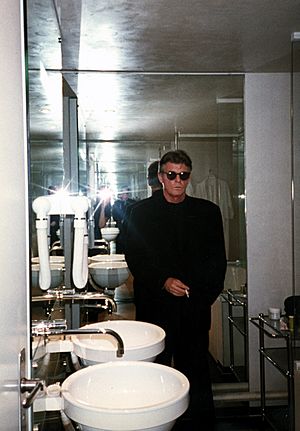Lewis Baltz facts for kids
Quick facts for kids
Lewis Baltz
|
|
|---|---|

Lewis Baltz (1998) in Jean Nouvel's Amat hotel
|
|
| Born | September 12, 1945 |
| Died | November 22, 2014 (aged 69) Paris, France
|
| Education | San Francisco Art Institute Claremont Graduate School |
| Occupation | Visual artist, photographer, educator |
| Known for | New Topography |
Lewis "Duke" Baltz (September 12, 1945 – November 22, 2014) was an American visual artist, photographer, and educator. He was an important figure in the New Topographics movement of the late 1970s. His best known work was monochrome photography of suburban landscapes and industrial parks which highlighted his commentary of void within the "American Dream".
He wrote for many journals, and contributed regularly to L'Architecture d'Aujourd'hui.
Baltz's work is held in the collections of the Solomon R. Guggenheim Museum, Metropolitan Museum of Art, Tate Modern, Los Angeles County Museum of Art, Whitney Museum of American Art, Art Institute of Chicago, Museum of Contemporary Art San Diego, Philadelphia Museum of Art and San Francisco Museum of Modern Art.
Early life and education
Lewis Baltz was born on September 12, 1945 in Newport Beach, California. His father died when he was age 11.
Baltz graduated with a BFA degree in Fine Arts from San Francisco Art Institute in 1969; and held a Master of Fine Arts degree from Claremont Graduate School (now Claremont Graduate University).
Career
His work is focused on searching for beauty in desolation and destruction. Baltz's images describe the architecture of the human landscape: offices, factories and parking lots. His pictures are the reflection of control, power, and influenced by and over human beings. His minimalistic photographs in the trilogy Ronde de Nuit, Docile Bodies, and Politics of Bacteria, picture the void of the other. In 1974 he captured the anonymity and the relationships between inhabitation, settlement and anonymity in The New Industrial Parks near Irvine, California (1974).
His books and exhibitions, his "topographic work", such as The New Industrial Parks, Nevada, San Quentin Point, Candlestick Point, expose the crisis of technology and define both objectivity and the role of the artist in photographs. His work Candlestick Point is made of 84 photographs documenting a public space near Candlestick Park, ruined by natural detritus and human intervention.
Baltz moved to Europe in the late 1980s and started to use large colored prints.
He published several books of his work including Geschichten von Verlangen und Macht, with Slavica Perkovic (Scalo, 1986). Other photographic series, including Sites of Technology (1989–92), depict the clinical, pristine interiors of hi-tech industries and government research centres, principally in France and Japan. In 1995, the story Deaths in Newport was produced as a book and CD-ROM. Baltz also produced a number of video works.
Baltz taught at various institutions, including Claremont Graduate School, California Institute of the Arts (CalArts), University of California, Riverside (UC Riverside), California State University, San Bernardino, and the IUAV University in Venice, Italy, where in 2006 he co-founded the Arsenale Institute for Politics of Representation.
End of life, death and legacy
In 2002, Baltz became a Professor for Photography at the European Graduate School in Saas-Fee, Switzerland. He lived his last years between Paris and Venice. Baltz died on November 22, 2014 in Paris at the age of 69 following a long illness.
Awards
He received several scholarships and awards including a scholarship from the National Endowment For the Arts (1973, 1977), the John Simon Guggenheim Memorial Fellowship (1977), US-UK Bicentennial Exchange Fellowship (1980), and Charles Brett Memorial Award (1991).
Collections
Baltz's work is held in the following permanent collections:
- Solomon R. Guggenheim Museum
- Metropolitan Museum of Art
- Tate Modern
- Los Angeles County Museum of Art
- Whitney Museum of American Art
- Art Institute of Chicago
- Museum of Contemporary Art San Diego
- Philadelphia Museum of Art
- San Francisco Museum of Modern Art
See also
 In Spanish: Lewis Baltz para niños
In Spanish: Lewis Baltz para niños

